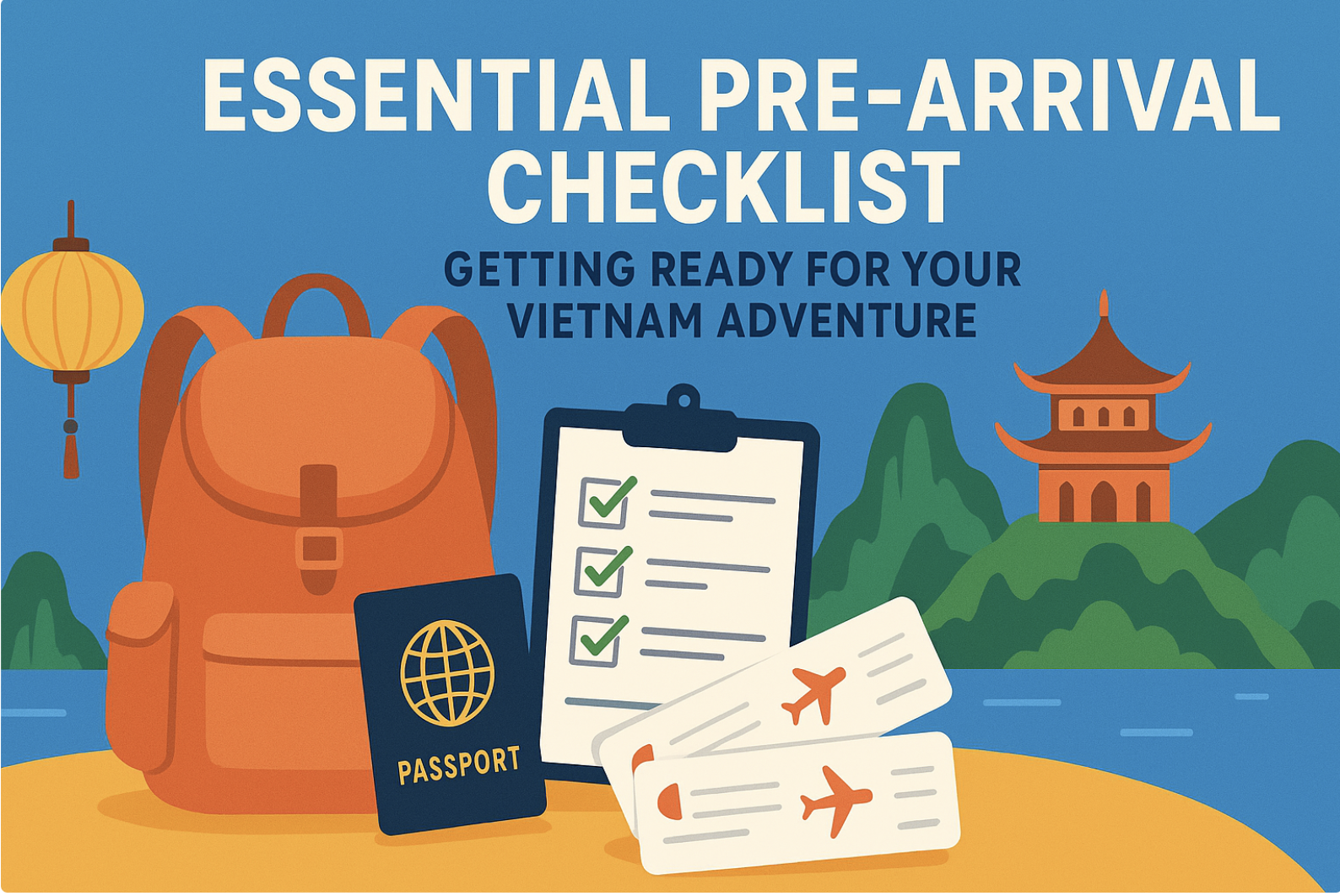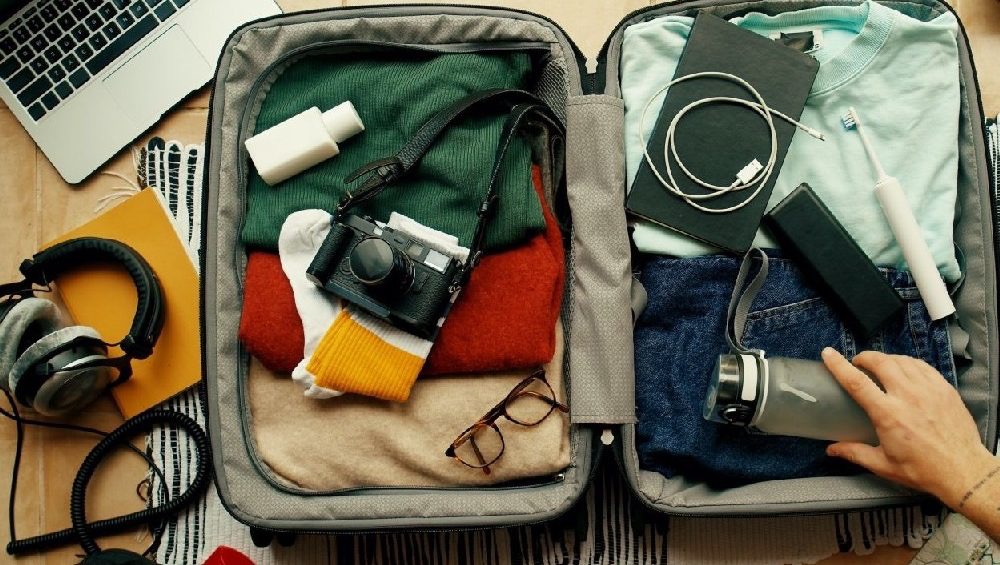
Last update: Monday October 22, 2025
Planning your first trip to Vietnam?
Whether you’re dreaming of the limestone cliffs of Ha Long Bay, the lantern-lit streets of Hoi An, or the vibrant bustle of Ho Chi Minh City, preparation is key to making your experience smooth and unforgettable.
This essential pre-arrival checklist for Vietnam covers everything you need to know before you go—from visas and vaccinations to packing tips and cultural etiquette.
Quick Summary: Vietnam Travel Essentials at a Glance
Before you dive into the details, here’s a snapshot of what you’ll need to prepare:
Visa and travel documents
Money and payment options
Health and safety essentials
Packing must-haves for Vietnam’s climate
Cultural awareness and basic Vietnamese phrases
Foreigners who enter Vietnam should check if your nationality requires a visa to enter Vietnam. Many travelers can enter visa-free for short stays ranging from 14 to 45 days, while others need an eVisa or a Visa On Arrival (both need you to apply online first). You can proactively check online whether your nationality requires a visa to enter Vietnam, or contact us for personalized advice through:
Hotline: +84.379.522.522
Email: sales@vietnam-immi.org
For your passport, you need to have it valid for at least six months and ensure your passport has a minimum of two (2) blank pages for visa stamps and entry/exit marks. Make sure to keep both printed and digital copies of your essential travel documents—including your passport, visa, and travel insurance—so you’ll be well-prepared in case of any loss or unexpected situation during your trip to Vietnam.
2. Health and Safety Preparations
Before traveling to Vietnam, it’s a good idea to prepare any allergy medications or personal medicines according to your health needs. Make sure to bring enough for your entire trip, keep them in their original packaging, and carry a copy of your prescription in case you need a refill or medical assistance during your stay.
Don’t forget to purchase comprehensive travel insurance that covers medical emergencies, trip cancellations, and lost luggage—while Vietnam’s healthcare system continues to improve, treatment at private hospitals can be costly without proper insurance coverage.

Photo: Collected
3. Money and Budget Planning
Vietnam’s official currency is the Vietnamese Dong (VND). While credit cards are increasingly accepted in major cities, cash remains the most common form of payment, especially in smaller towns, street markets, and local eateries. ATMs are widely available across the country and usually accept international debit and credit cards.
It’s a good idea to carry some small bills for everyday purchases like taxis, food stalls, and local shops. In terms of costs, Vietnam is generally an affordable destination—budget travelers can expect to spend around $25–$40 per day, mid-range travelers around $50–$100, and luxury travelers about $150 or more depending on comfort and activity choices.
4. What to Pack for Vietnam Trip
Clothing:
Lightweight, breathable clothes for the warm southern regions.
A light jacket or sweater for the cooler northern areas and mountain destinations like Sapa.
Comfortable walking shoes for exploring cities and nature spots.
A raincoat or poncho for unexpected tropical showers.
Swimwear for beach destinations.
Modest outfits for visiting temples and religious sites.
Travel Essentials:
A universal power adapter and portable charger to keep your devices powered.
A reusable water bottle to stay hydrated and reduce plastic waste.
Toiletries & Health Items:
Sunscreen and insect repellent for outdoor protection.
Hand sanitizer and basic toiletries.
A small first-aid kit with essential medicines for minor needs.
With these items, you’ll be well-prepared and comfortable throughout your journey across Vietnam’s diverse regions.

Photo: Collected
5. Learn the Basics and Stay Connected in Vietnam
Language & Etiquette
While English is widely spoken in tourist destinations, learning a few Vietnamese words shows respect and helps you connect with locals:
Hello – Xin chào
Thank you – Cảm ơn
How much? – Bao nhiêu tiền?
Delicious – Ngon quá
When exploring temples or local homes, remember to dress modestly, remove your shoes before entering, and avoid touching people’s heads or pointing your feet at others. Staying calm, patient, and polite is highly valued in Vietnamese culture and will leave a positive impression wherever you go.
Connectivity & Communication
Vietnam offers strong 4G coverage and widespread Wi-Fi access in hotels, cafés, and restaurants. You can stay connected easily by:
Buying a local SIM card from Viettel, Mobifone, or Vinaphone (available at airports and convenience stores).
Using an eSIM, if your phone supports it, for instant connectivity.
Downloading useful apps such as Grab (transport), Google Maps (navigation)
Getting Around Vietnam
Transportation in Vietnam is convenient and affordable with:
Domestic flights connect major cities quickly and efficiently.
Trains offer scenic routes—especially between Hanoi and Da Nang.
In cities, Grab and taxis are the easiest ways to get around.
If you plan to rent a motorbike, make sure you have an international driving permit and always wear a helmet for safety.
With a few Vietnamese phrases, proper etiquette, reliable connectivity, and easy transportation options, you’ll be fully prepared to explore Vietnam confidently and comfortably.
6. Frequently Asked Questions
What’s the best time to visit Vietnam?
The best time to travel is from October to April when the weather is cooler and drier across most regions.
Can I drink tap water in Vietnam?
It's not recommended to drink tap water in Vietnam. As a precaution, drink bottled or filtered water. Most hotels provide complimentary bottled water daily.
Is Vietnam safe for solo travelers?
Yes. Vietnam is one of Southeast Asia’s safest destinations. Just use common sense—avoid showing valuables and be careful with street motorbike offers.
Whether you need a fast visa, airport fast track, private car, or eSIM, Vietnam-Immi.org is here 24/7 to support your trip.
Whatsapp: +84379522522
Hotline: +84.379.522.522
Email: sales@vietnam-immi.org